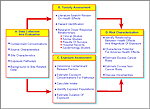
Figure 2: Risk Assessment Methodology
During and after the Gulf War, reports began to surface of DoD military and civilian personnel who believed that they had been exposed to a variety of environmental and occupational hazards during their service in the Gulf. To estimate the health risks from such exposures, DoD adopted a health risk assessment methodology based on that used by the US Environmental Protection Agency (US EPA). This methodology, as adapted for use in the Oil Well Fires investigation is illustrated in Figure 2. The Office of the Special Assistant for Gulf War Illnesses adapted this process to estimate the health risks from exposures to contaminants contained in the oil well fire smoke. It consists of four steps: Data Collection and Evaluation, Toxicity Assessment, Exposure Assessment, and Risk Characterization.

Figure
2: Risk Assessment Methodology
A. Data Collection and Evaluation
This involves gathering and analyzing background information related to the study area (i.e., the Persian Gulf Region) and contaminant data relevant to the investigation at hand. Data on such factors as soil characteristics of the region, climatic data, industrial activity, pollutant concentration data collected during monitoring studies, pollutant chemical and physical property data, and contaminant levels in the various environmental media (i.e., air, water, and soil) are required for a quality database. The data and information gathered can then be used in subsequent phases of the assessment.
Data and information sources used in this investigation include, but were not limited to:
Toxicity Assessments rely heavily on existing toxicity information developed on specific chemicals. Their purpose is to weigh available evidence regarding the potential for selected contaminants to cause adverse health effects (carcinogenic and non-carcinogenic). Toxicity assessments are typically performed in two steps: hazard identification followed by a dose-response assessment. Hazard identification involves determining whether exposure to an agent can cause an increase in the incidence of an adverse health effect. Dose-response assessment is the process of quantitatively evaluating the toxicity information and characterizing the relationship between the dose of the contaminant received and the incidence of adverse health effects in the exposed population. Information on hazard identification and dose-response relationships is typically obtained through literature searches and review of existing clinical studies, animal studies, work place exposures, and other supporting information that describe the workings of contaminants in the human body. Collectively these sources of information provide insight into the mechanism of action of a particular compound.
An assessment of the toxicity of contaminants associated with oil well fires was undertaken by the RAND Corporation[4] and involved a detailed literature search and an analysis of health effects studies. Results of this investigation are discussed in Section V (Health Effects Assessment) of this report.
These analyses are conducted to estimate the magnitude of actual and/or potential human exposures, the frequency and duration of these exposures, and the pathways by which humans are potentially exposed. Conducting an exposure assessment involves analyzing contaminant releases, identifying exposed populations, identifying all potential pathways of exposure, estimating exposure point concentrations for specific pathways (based both on environmental monitoring data and predictive chemical modeling results), and estimating contaminant intakes for specific pathways. To arrive at this assessment an investigation and validation process was developed, and included:
Risk Characterization is the culmination of the health risk methodology. Its purpose is to characterize the potential for adverse health effects by identifying the relationship between reported health outcomes and the magnitude of the exposures recorded or modeled. It combines the outputs of the exposure and toxicity assessments to complete a baseline health risk assessment, both in quantitative expressions and qualitative statements. To determine whether contaminant levels are a concern, the risk assessment process compares chemical-specific toxicity against measured contaminant exposure levels and those levels predicted through environmental modeling. The resulting risk estimates are expressed in terms of potential excess cancers, and the onset of non-carcinogenic effects (i.e., damage to the cardio-pulmonary, renal, neurological, and reproductive systems).
Two health risk assessment studies have been undertaken by the US Army to assess the potential health impacts on US troops exposed to the oil fire smoke during the Gulf War conflict. These studies were conducted to determine the extent of oil fire contaminant distribution and the related health risks to exposed DoD civilian and military personnel deployed to the Persian Gulf. The US Army Environmental Hygiene Agency (USAEHA) conducted the first study shortly after the war.[5]
The second study, completed by USAEHA under its new organizational title, the US Army Center for Health Promotion and Preventive Medicine (USACHPPM)[6] , is an expansion of the original USAEHA study. In this study, USACHPPM is providing more detail on the specific troop units that were exposed to the oil fire smoke. USACHPPM also conducted environmental modeling to estimate the concentration of contaminants to which the troops were exposed throughout Kuwait and Saudi Arabia. While the USAEHA risk assessment was based on a maximum estimated risk at a limited number of locations in theater, the USACHPPM study expanded the scope. USACHPPM estimated the risk to troop units throughout the theater based on their proximity to defined oil fire smoke plume boundaries, modeled concentrations of contaminants within these boundaries, and the length of time units were in these locations. Results of both of these studies can be found in Section VI.
| First Page | Prev Page | Next Page |